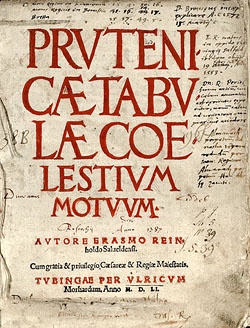
This copy was owned by both Liddel and by his Rostock professor Heinrich Brucaeus. It contains extensive manuscript commentaries and annotations by Brucaeus. These annotations are relevant not only to study the employment of astronomical tables in the late sixteenth century but also to investigate the interconnections between astronomy and literature in that age. In fact, the catalogue of the fixed stars is extensively annotated with stories and myths concerning the constellations, and quotations derived from classical authors.
The title page shown here has Brucaeus' notes and the remains of Erasmus Reinhold's signature. There is an example of an early signature of Liddel at Rostock dated 1587.
